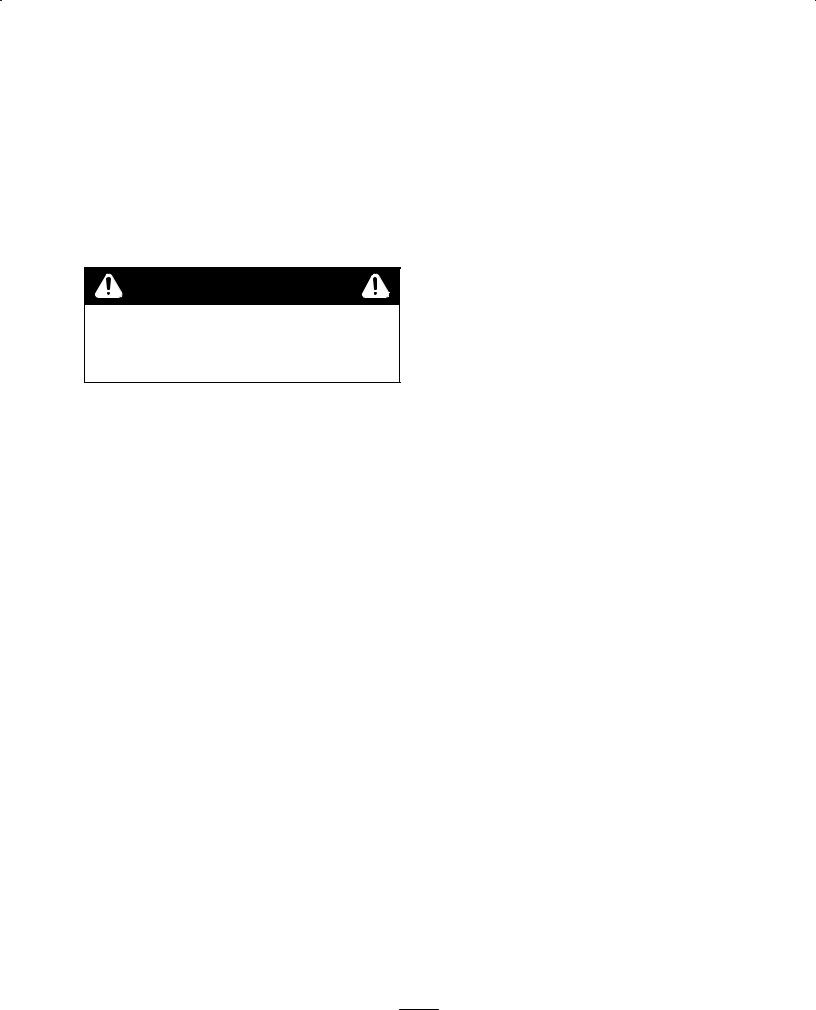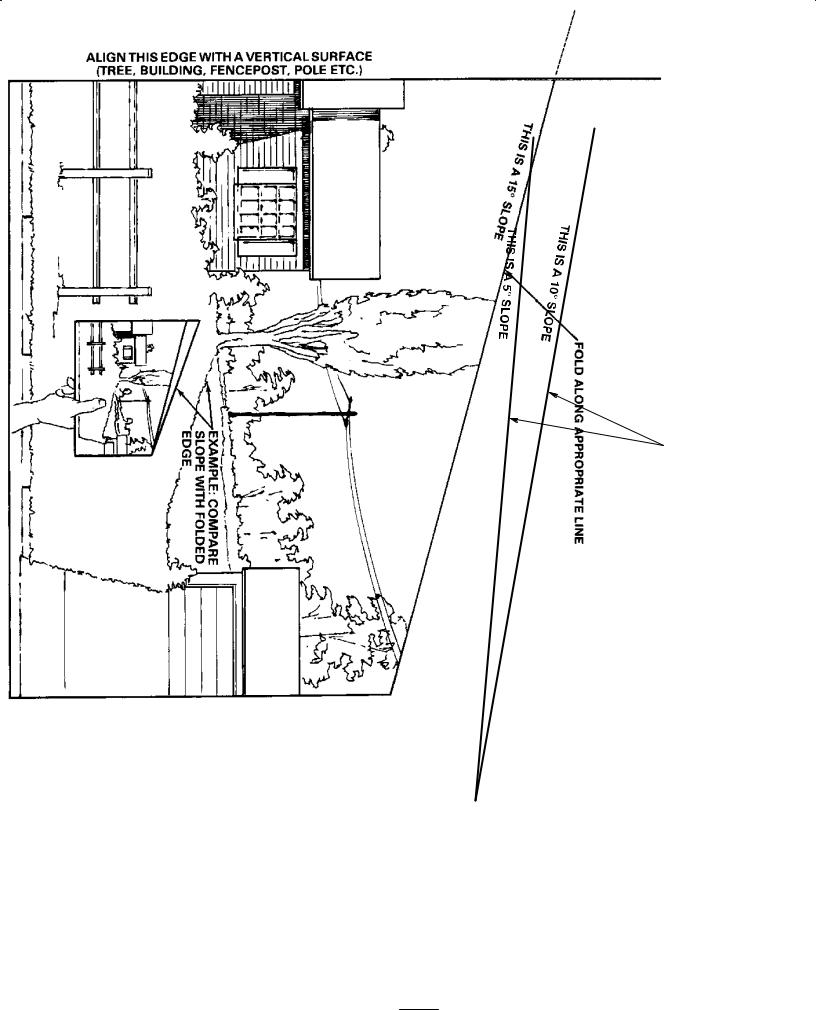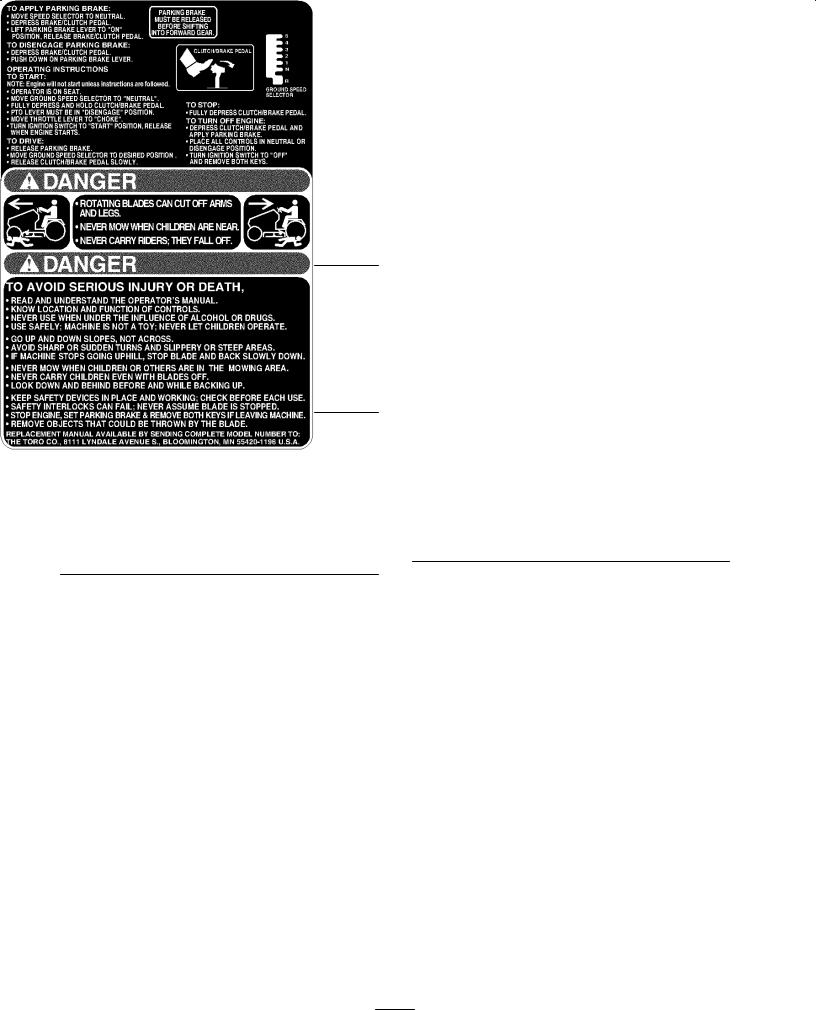Toro 71223 Operator's Manual

Form No. 3326-495 Rev B
16-38XL
Wheel Horse Lawn Tractor
Model No. 71223ÐSerial No. 220010001 and Up
Operator's Manual
Domestic English (EN)

Warning
CALIFORNIA
Proposition 65 Warning
The engine exhaust from this product contains chemicals known to the State of California to cause cancer, birth defects, or other reproductive harm.
Important The engine in this product is not equipped with a spark arrester muffler. It is a violation of California Public Resource Code Section 4442 to use or operate this engine on any forest-covered, brush-covered, or grass-covered land as defined in CPRC 4126. Other states or federal areas may have similar laws.
This spark ignition system complies with Canadian ICES-002.
Ce système d'allumage par étincelle de véhicule est conforme à la norme NMB-002 du Canada.
The enclosed Engine Owner's Manual is supplied for information regarding The U.S. Environmental Protection Agency (EPA) and the California Emission Control Regulation of emission systems, maintenance and warranty.
Keep this engine Owner's Manual with your unit. Should this engine Owner's Manual become damaged or illegible, replace immediately. Replacements may be ordered through the engine manufacturer.
Contents |
|
|
Page |
Introduction . . . . . . . . . . . . . . . . . . . . . . . . . . . . . . . . |
3 |
Safety . . . . . . . . . . . . . . . . . . . . . . . . . . . . . . . . . . . . . |
3 |
Safe Operating Practices . . . . . . . . . . . . . . . . . . . . |
3 |
Toro Riding Mower Safety . . . . . . . . . . . . . . . . . . |
5 |
Slope Chart . . . . . . . . . . . . . . . . . . . . . . . . . . . . . . |
7 |
Safety and Instruction Decals . . . . . . . . . . . . . . . . |
9 |
Gasoline and Oil . . . . . . . . . . . . . . . . . . . . . . . . . . . . . |
12 |
Recommended Gasoline . . . . . . . . . . . . . . . . . . . . |
12 |
Using Stabilizer/Conditioner . . . . . . . . . . . . . . . . |
12 |
Filling the Fuel Tank . . . . . . . . . . . . . . . . . . . . . . |
12 |
Checking the Engine Oil Level . . . . . . . . . . . . . . |
12 |
Operation . . . . . . . . . . . . . . . . . . . . . . . . . . . . . . . . . . |
13 |
Controls . . . . . . . . . . . . . . . . . . . . . . . . . . . . . . . . |
13 |
Using the Parking Brake . . . . . . . . . . . . . . . . . . . . |
13 |
Positioning the Seat . . . . . . . . . . . . . . . . . . . . . . . |
14 |
Operating the Headlights . . . . . . . . . . . . . . . . . . . |
14 |
Using the Blade Control (PTO) . . . . . . . . . . . . . . |
14 |
Setting the Height-of-Cut . . . . . . . . . . . . . . . . . . . |
14 |
|
Page |
Starting the Engine . . . . . . . . . . . . . . . . . . . . . . . . |
14 |
Stopping the Engine . . . . . . . . . . . . . . . . . . . . . . . |
15 |
Using the Safety Interlock System . . . . . . . . . . . . |
15 |
Testing the Safety Interlock System . . . . . . . . . . . |
16 |
Driving the Tractor Forward or Backward . . . . . . |
17 |
Selecting the Ground Speed . . . . . . . . . . . . . . . . . |
17 |
Stopping the Tractor . . . . . . . . . . . . . . . . . . . . . . . |
17 |
Side Discharging or Mulching the Grass . . . . . . . |
17 |
Installing the Discharge Cover . . . . . . . . . . . . . . . |
17 |
Operating Tips . . . . . . . . . . . . . . . . . . . . . . . . . . . |
18 |
Maintenance . . . . . . . . . . . . . . . . . . . . . . . . . . . . . . . . |
19 |
Recommended Maintenance Schedule . . . . . . . . . |
19 |
Servicing the Engine Oil . . . . . . . . . . . . . . . . . . . |
20 |
Servicing the Air Cleaner . . . . . . . . . . . . . . . . . . . |
21 |
Servicing the Spark Plug . . . . . . . . . . . . . . . . . . . |
22 |
Servicing the Brake . . . . . . . . . . . . . . . . . . . . . . . |
23 |
Greasing and Lubricating the Tractor . . . . . . . . . . |
23 |
Checking the Tire Pressure . . . . . . . . . . . . . . . . . . |
24 |
Servicing the Battery . . . . . . . . . . . . . . . . . . . . . . |
24 |
Draining the Fuel Tank . . . . . . . . . . . . . . . . . . . . . |
26 |
Replacing the Fuel Filter . . . . . . . . . . . . . . . . . . . |
27 |
Servicing the Fuse . . . . . . . . . . . . . . . . . . . . . . . . |
27 |
Servicing the Headlights . . . . . . . . . . . . . . . . . . . . |
27 |
Servicing the Blade . . . . . . . . . . . . . . . . . . . . . . . |
28 |
Removing the Mower . . . . . . . . . . . . . . . . . . . . . . |
29 |
Installing the Mower . . . . . . . . . . . . . . . . . . . . . . |
31 |
Replacing the Blade Drive Belt . . . . . . . . . . . . . . |
32 |
Leveling the Mower from Side-to-Side . . . . . . . . |
33 |
Adjusting the Front-to-Rear Blade Slope . . . . . . . |
33 |
Washing the Underside of the Mower . . . . . . . . . |
35 |
Cleaning and Storing the Tractor . . . . . . . . . . . . . |
35 |
Wiring Diagram . . . . . . . . . . . . . . . . . . . . . . . . . . |
37 |
Troubleshooting . . . . . . . . . . . . . . . . . . . . . . . . . . . . . |
38 |
The Toro Total Coverage Guarantee . . . . . . . . . . . . . |
40 |
2002 by The Toro Company |
|
|
8111 Lyndale Avenue South |
|
All Rights Reserved |
|
||
Bloomington, MN 55420-1196 |
2 |
Printed in the USA |

Introduction
Read this manual carefully to learn how to operate and maintain your product properly. The information in this manual can help you and others avoid injury and product damage. Although Toro designs and produces safe products, you are responsible for operating the product properly and safely.
Whenever you need service, genuine Toro parts, or additional information, contact an Authorized Service Dealer or Toro Customer Service and have the model and serial numbers of your product ready. Figure 1 illustrates the location of the model and serial numbers on the product.
1
m-1856
Figure 1
1. Location of the model and serial numbers
Write the product model and serial numbers in the space below:
Model No.
Serial No.
This manual identifies potential hazards and has special safety messages that help you and others avoid personal injury and even death. Danger, Warning, and Caution are signal words used to identify the level of hazard. However, regardless of the hazard, be extremely careful.
Danger signals an extreme hazard that will cause serious injury or death if you do not follow the recommended precautions.
Warning signals a hazard that may cause serious injury or death if you do not follow the recommended precautions.
Caution signals a hazard that may cause minor or moderate injury if you do not follow the recommended precautions.
This manual uses 2 other words to highlight information. Important calls attention to special mechanical
information and Note: emphasizes general information worthy of special attention.
Safety
This tractor meets or exceeds the B71.1±1998 specifications of the American National Standards Institute in effect at the time of production.
Read and understand the contents of this manual before operating the tractor.
 This is the safety alert symbol. It is used to alert you to potential personal injury hazards. Obey all safety messages that follow this symbol to avoid all possible injury or death.
This is the safety alert symbol. It is used to alert you to potential personal injury hazards. Obey all safety messages that follow this symbol to avoid all possible injury or death.
Safe Operating Practices
The following instructions are from ANSI standard B71.1Ð1998.
This product is capable of amputating hands and feet and throwing objects. Always follow all safety instructions to avoid serious injury or death.
General Operation
•Read, understand, and follow all instructions in the operator's manual and on the machine before starting.
•Allow only responsible adults who are familiar with the instructions to operate the machine.
•Clear the area of objects such as rocks, toys, wire, etc., which could be picked up and thrown by the blade.
•Be sure the area is clear of other people before mowing. Stop the machine if anyone enters the area.
•Never carry passengers.
•Do not mow in reverse unless absolutely necessary. Always look down and behind before and while backing.
•Be aware of the mower discharge direction and do not point it at anyone. Do not operate the mower without either the entire grass catcher or the guard in place.
•Slow down before turning.
•Never leave a running machine unattended. Always turn off blades, set parking brake, stop engine, and remove keys before dismounting.
•Turn off blades when not mowing.
•Stop the engine before removing the grass catcher or unclogging the chute.
•Mow only in daylight or good artificial light.
•Do not operate the machine while under the influence of alcohol or drugs.
3

•Watch for traffic when operating near or crossing roadways.
•Use extra care when loading or unloading the machine into a trailer or truck.
•Always wear safety goggles or safety glasses with side shields when operating mower.
•Data indicates that operators, age 60 years and above, are involved in a large percentage of riding mower±related injuries. These operators should evaluate their ability to operate the riding mower safely enough to protect themselves and others from serious injury.
Slope Operation
Slopes are a major factor related to loss-of-control and tip-over accidents, which can result in severe injury or death. All slopes require extra caution. If you cannot back up the slope or if you feel uneasy on it, do not mow it.
•Mow up and down slopes, not across.
•Remove obstacles such as rocks, tree limbs, etc.
•Watch for holes, ruts or bumps. Uneven terrain could overturn the machine. Tall grass can hide obstacles.
•Use slow speed. Choose a low gear so that you will not have to stop or shift while on the slope.
•Follow Toro's recommendations for wheel weight or counterweights to improve stability.
•Use extra care with grass catchers or other attachments. These can change the stability of the machine.
•Keep all movement on slopes slow and gradual. Do not make sudden changes in speed or direction.
•Avoid starting or stopping on a slope. If tires lose traction, disengage the blades and proceed slowly straight down the slope.
•Do not turn on slopes unless necessary, and then, turn slowly and gradually downhill, if possible.
•Do not mow near drop-offs, ditches, or embankments. The machine could suddenly turn over if a wheel goes over the edge of a cliff or ditch, or if an edge caves in.
•Do not mow on wet grass. Reduced traction could cause sliding.
•Do not try to stabilize the machine by putting your foot on the ground.
•Do not use a grass catcher on steep slopes.
Children
Tragic accidents can occur if the operator is not alert to the presence of children. Children are often attracted to the machine and the mowing activity. Never assume that children will remain where you last saw them.
•Keep children out of the mowing area and under the watchful care of another responsible adult.
•Be alert and turn the machine off if children enter the area.
•Before and while backing, look behind and down for small children.
•Never carry children, even with the blades off. They may fall off and be seriously injured or interfere with safe machine operation.
•Never allow children to operate the machine.
•Use extra care when approaching blind corners, shrubs, trees, the end of a fence or other objects that may obscure vision.
Service
•Use extra care when handling gasoline and other fuels. They are flammable and vapors are explosive.
±Use only an approved container.
±Never remove the gas cap or add fuel when the engine is running. Allow the engine to cool before refueling. Do not smoke.
±Never refuel the machine indoors.
±Never store the machine or fuel container inside where there is an open flame, such as near a water heater or furnace.
•Never run a machine inside a closed area.
•Keep nuts and bolts tight, especially the blade attachment bolts. Keep equipment in good condition.
•Never tamper with safety devices. Check their proper operation regularly.
•Keep the machine free of grass, leaves, or other debris build-up. Clean up oil or fuel spillage. Allow the machine to cool before storing.
•Stop and inspect the equipment if you strike an object. Repair, if necessary, before restarting.
•Grass catcher components are subject to wear, damage and deterioration, which could expose moving parts or allow objects to be thrown. Frequently check components and replace with manufacturer's recommended parts, when necessary.
4

• Mower blades are sharp and can cut. Wrap the blade(s) |
• Do not use a grass catcher on steep slopes. Heavy grass |
or wear gloves, and use extra caution when servicing |
bags could cause loss of control or overturn the |
them. |
machine. |
•Use only genuine Toro replacement parts to ensure that original standards are maintained.
Toro Riding Mower Safety
The following list contains safety information specific to Toro products or other safety information that you must know that is not included in the ANSI standards.
Warning
Engine exhaust contains carbon monoxide, which is an odorless, deadly poison that can kill you.
Do not run engine indoors or in an enclosed area.
•Stop the engine, disconnect spark plug wire and remove key before performing any service, repairs, maintenance or adjustments.
•Slow down before turning. Sharp turns on any terrain may cause loss of control.
•Never leave a running machine unattended. Always turn
off blades, set parking brake, stop engine, and remove the ignition and KeyChoice keys before dismounting.
•Keep hands, feet, hair and loose clothing away from attachment discharge area, underside of mower and any moving parts while engine is running.
•Do not touch equipment or attachment parts which may be hot from operation. Allow to cool before attempting to maintain, adjust or service.
•Battery acid is poisonous and can cause burns. Avoid contact with skin, eyes and clothing. Protect your face, eyes and clothing when working with a battery.
•Battery gases can explode. Keep cigarettes, sparks and flames away from battery.
•Use only genuine replacement parts to ensure that original standards are maintained.
•Use only Toro approved attachments. Warranty may be voided if used with unapproved attachments.
•Do not mow across slopes exceeding 5 degrees.
•Do not mow down slopes exceeding 15 degrees.
•Do not mow up slopes exceeding 10 degrees.
•If a steep slope must be ascended, back up the hill, and drive forward down the hill, keeping the machine in gear.
•Avoid turning on slopes. If you must turn, turn slowly and gradually downhill, if possible.
5

6

Slope Chart
7

8

Safety and Instruction Decals
Safety decals and instructions are easily visible to the operator and are located near any area of potential danger. Replace any decal that is damaged or lost.
55-4300
68-3650
68-3660
92-2462
79-3140
93-1122
92-2461
9

93-6679
1. Engine
99-2985
99-6094
99-5339
10

104-4163
1.Explosion hazard
2.No fire, open flames, or smoking.
3.Caustic liquid/chemical burn hazard
4.Wear eye protection
5.Read the Operator's
Manual.
6.Keep bystanders a safe distance from the battery.
99-8139
1.Contains lead; do not discard.
2.Recycle
3.Wear eye protection; explosive gases can cause blindness and other injuries
104-4164
4. |
No sparks, flame, or |
6. |
Flush eyes immediately with |
|
smoking |
|
water and get medical help |
5. |
Sulfuric acid can cause |
|
fast. |
|
|
||
|
blindness or severe burns. |
7. |
Maximum fill line |
8.Minimum fill line
9.Instructions for activating the battery
11

Gasoline and Oil
Recommended Gasoline
Use unleaded regular gasoline suitable for automotive use (85 pump octane minimum). You may use leaded regular gasoline if unleaded regular is not available.
Important Never use methanol, gasoline containing methanol, or gasohol containing more than 10% ethanol because the fuel system could be damaged. Do not mix oil with gasoline.
Danger
In certain conditions, gasoline is extremely flammable and highly explosive. A fire or explosion from gasoline can burn you and others and can damage property.
•Fill the fuel tank outdoors in an open area when the engine is cold. Wipe up any gasoline that spills.
•Do not fill the fuel tank completely full. Add gasoline to the fuel tank until the level is 1/4 to 1/2 in. (6 to 13 mm) below the bottom of the filler neck. This empty space in the tank allows the gasoline to expand.
•Never smoke when handling gasoline, and stay away from an open flame or where a spark may ignite the gasoline fumes.
•Store gasoline in an approved container and keep it out of the reach of children.
•Never buy more than a 30-day supply of gasoline.
•Always place gasoline containers on the ground away from your vehicle before filling.
•Do not fill gasoline containers inside a vehicle or on a truck or trailer bed because interior carpets or plastic truck bed liners may insulate the container and slow the loss of any static charge.
•When practical, remove gas-powered equipment from the truck or trailer and refuel the equipment with its wheels on the ground.
•If this is not possible, refuel such equipment on a truck or trailer from a portable container, not from a gasoline dispenser nozzle.
•If you must use a gasoline dispenser, keep the nozzle in contact with the rim of the fuel tank or container opening at all times until fueling is complete.
Using Stabilizer/Conditioner
Use a fuel stabilizer/conditioner in the tractor to provide the following benefits:
•It keeps gasoline fresh during storage for up to 90 days. For longer storage, drain the fuel tank.
•It cleans the engine while it runs.
•It eliminates gum-like varnish buildup in the fuel system, which causes hard starting.
Important Do not use fuel additives containing methanol or ethanol.
Add the correct amount of fuel stabilizer/conditioner to the gasoline.
Note: A fuel stabilizer/conditioner is most effective when it is mixed with fresh gasoline. To minimize the chance of varnish deposits in the fuel system, use a fuel stabilizer/conditioner at all times.
Filling the Fuel Tank
1.Stop the engine and wait for all moving parts to stop.
2.Set the parking brake.
3.Clean around the fuel tank cap and remove the cap.
4.Add unleaded regular gasoline to the fuel tank until the level is 1/4 to 1/2 in. (6 to 13 mm) below the bottom of the filler neck. Do not fill the fuel tank completely full.
Note: This space in the tank allows gasoline to expand.
5.Install the fuel tank cap securely.
6.Wipe up any gasoline that spills.
Checking the Engine Oil Level
Before you start the engine and use the tractor, check the oil level in the engine crankcase; refer to Checking the Oil Level on page 20.
12
